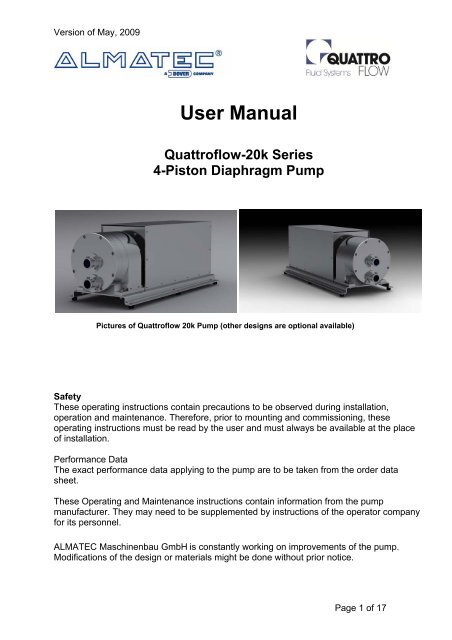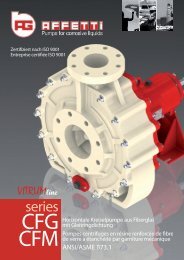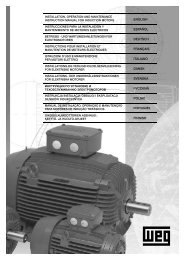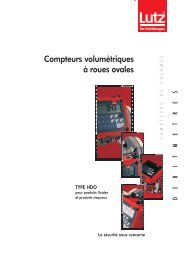User Manual Quattroflow-20k Series 4-Piston Diaphragm Pump
User Manual Quattroflow-20k Series 4-Piston Diaphragm Pump
User Manual Quattroflow-20k Series 4-Piston Diaphragm Pump
Create successful ePaper yourself
Turn your PDF publications into a flip-book with our unique Google optimized e-Paper software.
Version of May, 2009<br />
<strong>User</strong> <strong>Manual</strong><br />
<strong>Quattroflow</strong>-<strong>20k</strong> <strong>Series</strong><br />
4-<strong>Piston</strong> <strong>Diaphragm</strong> <strong>Pump</strong><br />
Pictures of <strong>Quattroflow</strong> <strong>20k</strong> <strong>Pump</strong> (other designs are optional available)<br />
Safety<br />
These operating instructions contain precautions to be observed during installation,<br />
operation and maintenance. Therefore, prior to mounting and commissioning, these<br />
operating instructions must be read by the user and must always be available at the place<br />
of installation.<br />
Performance Data<br />
The exact performance data applying to the pump are to be taken from the order data<br />
sheet.<br />
These Operating and Maintenance instructions contain information from the pump<br />
manufacturer. They may need to be supplemented by instructions of the operator company<br />
for its personnel.<br />
ALMATEC Maschinenbau GmbH is constantly working on improvements of the pump.<br />
Modifications of the design or materials might be done without prior notice.<br />
Page 1 of 17
Version of May, 2009<br />
1. General<br />
1.1 Appropriate Specification<br />
1.2 Labelling of the <strong>Pump</strong><br />
2. Safety<br />
2.1 Marking of precautions in the operating instructions<br />
2.2 Personnel qualification and personnel training<br />
2.3 Responsible working<br />
2.4 Dangers in case of non-compliance with the safety precautions<br />
2.5 Safety precautions fort the user and/or operator<br />
2.6 Safety precautions for maintenance, inspection and mounting operations<br />
2.7 Arbitrary reconstruction and spare part production<br />
2.9 Attention! Warning precautions!<br />
2.10 Attention! Safety precautions!<br />
3. Description of the <strong>Quattroflow</strong> <strong>20k</strong> <strong>Pump</strong><br />
3.1 Application and range of utilization of the <strong>Quattroflow</strong> <strong>20k</strong> pump<br />
3.2 Typical application of the <strong>Quattroflow</strong> <strong>20k</strong> pump<br />
3.3 Description of the function of the <strong>Quattroflow</strong> <strong>20k</strong> pump<br />
3.4 Start-up<br />
4. Maintenance and servicing of the <strong>Quattroflow</strong> <strong>20k</strong> pump<br />
4.1 Dismounting of the pump chamber and changing of<br />
the diaphragms and valves<br />
4.2 Mounting of the pump chamber<br />
4.3 Dismounting of the shaft bearing cap unit<br />
5. Operating troubles, causes and remedial actions<br />
5.1 <strong>Pump</strong> does not start<br />
5.2 <strong>Pump</strong> does not prime<br />
5.3 Delivery is not obtained<br />
5.4 Pressure head is not obtained<br />
5.5 Irregular pump delivery<br />
5.6 <strong>Pump</strong> operates noisily<br />
5.7 <strong>Pump</strong> is leaky<br />
5.8 Motor gets to warm<br />
6. Performance chart of the <strong>Quattroflow</strong> <strong>20k</strong> pump<br />
6.1 Diagram 1 Discharge as function of pump rpm<br />
7. Technical data of the <strong>Quattroflow</strong> <strong>20k</strong> pump<br />
Page 2 of 17
Version of May, 2009<br />
1. General:<br />
1.1 Appropriate specification<br />
This <strong>User</strong> <strong>Manual</strong> is valid for the <strong>Quattroflow</strong> Q<strong>20k</strong> pump<br />
No liability will be undertaken for any damages caused by non-compliance with the operating<br />
instructions and service conditions! Original spare parts serve safety purposes. The use of other<br />
parts may cancel the liability for the consequences resulting there from.<br />
Manufacturer: ALMATEC Maschinenbau GmbH<br />
Carl-Friedrich-Gauss-Str. 5<br />
D-47475 Kamp-Lintfort<br />
Germany<br />
Phone: +49 2842 961-0<br />
Fax: +49 2842 961-40<br />
e-mail: quattroflow@almatec.de<br />
Internet: www.quattroflow.com<br />
1.2 Labelling of the pump<br />
The type label of each <strong>Quattroflow</strong> pump can be seen on the bottom of the base plate.<br />
Besides the serial No of the pump head is punshed in, at the front cover.<br />
Page 3 of 17
Version of May, 2009<br />
2. Safety<br />
The operating instructions are recommended to be followed during installation, operation and maintenance.<br />
Prior to mounting and commissioning, the operating instructions must be followed by authorized personnel.<br />
The manual should be kept with the pump for future reference. The general safety warnings in Section 2<br />
“Safety” are to be observed, in addition to the safety procedures for the user’s site.<br />
2.1 Warning Symbols<br />
If the safety warnings contained in the operating instructions are not followed, this may result in danger to<br />
personnel or surroundings. The following symbols indicate the necessary precaution for the particular hazard.<br />
Danger Warning:<br />
Safety sign according to DIN 4844 - W 9<br />
Electrical Shock Warning:<br />
Safety sign according to DIN 4844 – W8<br />
Safety procedures that are not followed may cause danger to the pump itself or to parts of the system are<br />
marked with the word or indication:<br />
● ATTENTION<br />
● Pmax 8 bar<br />
● Direction of flow<br />
Removing or damaging warning labels and signs is prohibited.<br />
2.2 Precautions for maintenance, inspection, mounting and operation<br />
The customer shall see to it that all maintenance, inspection and mounting operations are performed by<br />
authorized and qualified personnel. <strong>Pump</strong> maintenance should be performed only when the pump is stopped<br />
and power is disconnected. <strong>Pump</strong>s handling hazardous materials must be decontaminated.<br />
2.3 Operator’s Responsibility<br />
Please follow the safety procedures provided by operator’s site or facility. For example, material handling,<br />
hazardous materials, biological materials, handling of tubing, piping, instrumentation, and fittings.<br />
Page 4 of 17
Version of May, 2009<br />
2.4 Non-compliance of safety warnings<br />
Failure to follow safety precautions may cause danger to personnel, equipment and environment.<br />
Such as:<br />
� Failure of the proper function of the pump/system.<br />
� Danger to personnel by electrical, mechanical, chemical, biological impacts.<br />
� Danger to equipment and environment<br />
2.5 Safety precautions for the operation<br />
Protective measures should be observed while processing hot fluids (i.e. CIP or SIP).<br />
Removing protecting covers of moving parts is prohibited.<br />
Hazardous material spills must be handled in accordance to local codes and procedures<br />
2.6 Safety precautions for maintenance, inspection and mounting operations<br />
The customer should verify that all maintenance, inspection and mounting operations are performed by<br />
authorized and qualified personnel.<br />
Maintenance and service of the pump must be performed while the pump is stopped.<br />
<strong>Pump</strong>s or aggregates handling hazardous fluids must be decontaminated.<br />
2.7 Arbitrary reconstruction and spare part construction<br />
Reconstruction of or changes to the machine are only admissible after consultation with the manufacturer.<br />
Original spare parts and accessories authorized by the manufacturer serve safety purposes. The use of other<br />
parts may cancel the liability for the consequences resulting here from.<br />
2.8 Inadmissible modes of operation<br />
The operating safety of the machine supplied is only ensured with due application according to the operating<br />
instructions. Do not exceed the limit values given in the data sheet.<br />
Page 5 of 17
Version of May, 2009<br />
2.9 Attention! Warning precautions!<br />
These warning precautions are to prevent the user from an inadmissible<br />
mode of operation. These warning precautions are to be strictly followed<br />
to avoid any damage of the pump and/or any danger to personnel.<br />
<strong>Diaphragm</strong> pumps are positive displacement pumps and can theoretically generate an infinitely<br />
high pressure. With the discharge line closed, for example by clogging or by incidental closing<br />
of a valve, the pressure generated by the pump may reach a multiple of the admissible pressure<br />
of the plant. This may lead to bursting of the diaphragm or lines which must be absolutely<br />
avoided especially when handling dangerous products.<br />
Diameter of the suction line need to be sufficient to avoid cavitation.<br />
The use of a safety device (i.e. pressure switch) can be necessary.<br />
Please make sure that prior to the start of the pump the discharge line is checked. Make sure that there is<br />
no flow restriction in the discharge line to avoid any over pressure (i.e. closed valve).<br />
Check all seals (i.e. TC clamps) before starting the pump.<br />
The maximum discharge pressure depends on the temperature of the fluid.<br />
Pmax at room temperature = 8 bar<br />
Pmax at 90° C = 3 bar<br />
Please allow the pump to cool down after heat treatment (i.e. CIP / SIP).<br />
Flush the pump prior to use with appropriate fluid (i.e. buffer)<br />
Foundation design: The foundation must be designed so that it can take the weight of the pump<br />
aggregate on the entire surface.<br />
Please make sure that the pump is operated with the proper mains voltage and frequency to avoid<br />
damages and electrical danger.<br />
Make sure that the slots for the cooling air are not blocked.<br />
Due to the versatile possibilities to use the <strong>Quattroflow</strong> Q<strong>20k</strong> pump it is highly recommended<br />
to check case by case if the <strong>Quattroflow</strong> Q<strong>20k</strong> pump will be the right tool for the specific<br />
application. The user/operator is responsible to perform a proper method of testing if the<br />
pump should be applied for his specific application.<br />
The chemical and thermal compatibility of the elastomeric parts of the pump with the fluid that will be pumped<br />
are to be checked by the operator before the first process run.<br />
For example, oily, fatty fluids or solvents might cause a swelling and/or destruction of the elastomers.<br />
If in doubt, please contact the manufacturer!<br />
Operating the pump in humid or aggressive air can cause damages to the motor and control box.<br />
The control box should not be exposed to spray/splash water or to heat sources.<br />
If the <strong>Quattroflow</strong> Q<strong>20k</strong> pump is to be used under rough conditions (i.e. high-pressure cleaners, exposed to<br />
sea water), the manufacturer can supply special equipment, like motors and controls.<br />
Page 6 of 17
Version of May, 2009<br />
2.10 Attention! Safety Precautions!<br />
The following safety precautions notify you of the potential of bodily harm or life<br />
danger of the user/operators!<br />
Please read and follow the safety precautions and warnings to avoid any risk of bodily harm, life<br />
danger and/or the damage of equipment.<br />
Please keep this <strong>User</strong> <strong>Manual</strong> available. Make sure that the operators of the pump have read and<br />
understood the <strong>User</strong> <strong>Manual</strong>. A training session might be appropriate.<br />
We recommend installing specific warning labels at the system.<br />
Disconnect mains before doing any maintenance!<br />
The housing of the control box is to be opened only by skilled personnel.<br />
Check the electrical cables before connecting to mains supply.<br />
The <strong>Quattroflow</strong> Q<strong>20k</strong> is a positive displacement pump and can theoretically generate an infinitely<br />
high pressure even at low speed (rpm). Prior to each start of the pump check and make sure that the<br />
discharge line is not closed or restricted. The design of the discharge line must not build up a<br />
pressure of >8 bar.<br />
If suction and/or discharge line are flexible tubing, then make sure that these tubing does have the<br />
proper pressure rating for the full range of temperatures that are applied.<br />
Pmax = 8 bar, Do not exceed! Warning Label: p max: 8 bar! Do not remove!<br />
If the maximum pressure is exceeded it can happen that the diaphragm of the pump will burst.<br />
In this case the fluid will come out of the pump and can cause a danger for the personnel<br />
and/or environment (i.e. caustic cleaner).<br />
The <strong>Quattroflow</strong> <strong>20k</strong> pump can pump air which means that most of the fluid inside the pump chamber will be<br />
pump out. However there will be a residual amount of fluid (approximately 100-500 ml) inside the pump<br />
chamber that should be flushed out of the pump before the pump will be opened.<br />
Please follow the general safety guidelines when handling chemical fluids (wear gloves and/or<br />
glasses) before the pump chamber will be opened.<br />
Never operate the pump without coupling and motor housing.<br />
The foundation must be designed so that it can take the weight of the pump on the entire surface.<br />
The <strong>Quattroflow</strong> <strong>20k</strong> must not be operated in ATEX zones.<br />
Please contact the manufacturer in case the <strong>Quattroflow</strong> <strong>20k</strong> pump needs to be modified for<br />
ATEX applications.<br />
ALMATEC Maschinenbau GmbH<br />
Attention! Inadmissible modes of operation, arbitrary reconstruction, spare parts production and/or<br />
any changes of the design (without admission of the manufacturer) may cancel the liability for the<br />
consequences resulting there from.<br />
Page 7 of 17
Version of May, 2009<br />
3. Description of the <strong>Quattroflow</strong> <strong>20k</strong> pump<br />
3.1 Application and range of utilization of the <strong>Quattroflow</strong> <strong>20k</strong> pump<br />
The <strong>Quattroflow</strong> <strong>20k</strong> is a 4-piston <strong>Diaphragm</strong> pump, which is mainly used to pump water-like fluids that are<br />
typically handled in research, pilot plant or production facilities of the pharmaceutical, biotech, food or<br />
cosmetic research centres or plants.<br />
Typical examples of these fluids:<br />
� Solutions containing proteins (albumin, IgG, Clotting factors, monoclonal antibodies,<br />
enzymes, vaccines.)<br />
� Solutions of polymers or suspensions (silicones, latex, chromatography media)<br />
� Cell suspensions (bacteria, yeast, algae, fungi, mammalian cells)<br />
� colloidal solutions<br />
� Suspensions of viruses or phages<br />
� Dairy products<br />
� Gelatin<br />
� Supplements and ingredients for cosmetic and food.<br />
3.2 Typical process steps in which the <strong>Quattroflow</strong> <strong>20k</strong> pump is used<br />
Filtration technology<br />
� To recirculate feed/retentate (i.e. membrane cassettes, hollow fibre, spiral wound, ceramic elements.<br />
� Feed pump for filter cartridges or plate and frame depth filters<br />
Chromatography:<br />
� Packing of chromatography columns<br />
� Feed pump to mix gradients<br />
� Feed pump for centrifuges or separators<br />
� Feed pump for homogenizers<br />
� Feed pump for filling machines<br />
3.3 Discription of the working princaple <strong>Quattroflow</strong> <strong>20k</strong><br />
The <strong>Quattroflow</strong> <strong>20k</strong> pump is a 4-piston diaphragm pump. The 4 segments of the pump diaphragm oscillate<br />
back and forth. This alternate movement is created by a nutation disc that is arranged on a ball bearing.<br />
The ball bearing sits on an eccentric shaft. The nutation disc does not turn!<br />
The stroke of the pistons is determined by the angle of the 7° eccenter shaft.<br />
Range of flow rate: appr. 750 -20.000 L/hr<br />
The drive = motor + control needs to be choosen according to application.<br />
Please note:<br />
The direction of flow can be adjusted by turning the pump chamber in 90° steps.<br />
The <strong>Quattroflow</strong> <strong>20k</strong> is self-priming and can run dry. Inside the pump chamber there are no rotating parts<br />
that might cause heating up of the product or shed particles.<br />
The pump-motor unit is mounted on a stainless steel base plate. In case that the pump will not be mounted on<br />
the base plate but in a frame or any other base measures have to be taken that there will be a proper<br />
alignment of the motor and the pump.<br />
Page 8 of 17
Version of May, 2009<br />
3.4 Start-Up<br />
Prior to leaving our factory all pumps are subjected to a leakage and performance test.<br />
Only properly operating pumps leave the factory achieving the performances assured by us.<br />
It is possible that there will be a few milliliters of water inside the pump.<br />
Prior to each use we recommend flushing the pump with a proper fluid (i.e. water or buffer)<br />
Prior to the very first use it might make sense to clean and sanitize the pump chamber.<br />
A commercial caustic cleaner and/or 0.5 to 1 mol of NaOH can be used.<br />
The chosen cleaning agent can be recirculated and also stored inside the pump chamber.<br />
For flushing out of any cleaning agent do not recirculate!<br />
Check with appropriate analytical methods the success of the flushing procedure.<br />
Please note:<br />
Recommendation: Test run prior first use!<br />
Before using your pump in your process (for example as recirculation pump in a TFF<br />
system) perform a test run to get used to the specific properties of the pump.<br />
ALMATEC Maschinenbau GmbH is also building custom-made pumps and set-ups.<br />
These modified pumps can be different from this one that is described in here.<br />
However the basic information is applicable to all of the <strong>Quattroflow</strong> <strong>20k</strong> <strong>Series</strong> pumps.<br />
Please do not hesitate to contact us for further information:<br />
ALMATEC Maschinenbau GmbH<br />
Carl-Friedrich-Gauss-Str. 5<br />
D-47475 Kamp-Lintfort<br />
Germany<br />
Phone: +49 2842 961-0<br />
Fax: +49 2842 961-40<br />
e-mail: quattroflow@almatec.de<br />
Internet: www.quattroflow.com<br />
Page 9 of 17
Version of May, 2009<br />
4. Maintenance/Servicing of the <strong>Quattroflow</strong> <strong>20k</strong> pump<br />
Due to the robust construction the <strong>Quattroflow</strong> <strong>20k</strong> pump requires only little and easy- to-do maintenance.<br />
The ball bearings do not need any extra lubrication.<br />
The diaphragm and the valves are wear parts. These should be checked and if needed be changed once the<br />
performance of the pump decreases.<br />
If the diaphragm breaks, it needs to be replaced. It is recommended to check the ball bearings, replace the<br />
ball bearings if the ball bearings are hard to turn or are noisy during operation.<br />
Attention! Safety precautions!<br />
After purging the pump with air there might be a small residual amount of<br />
fluid inside the pump chamber.<br />
Flush the pump chamber thoroughly and check the rinse fluid.<br />
Please<br />
follow the general guidelines and safety precautions when<br />
handling<br />
with chemicals.<br />
Disconnect mains supply before opening the pump h ousing!<br />
The dismounting and mounting of the pump should be done on a rigid<br />
table or work bench. Please note: the pump is heavy.<br />
Page 10 of 17
Version of May, 2009<br />
4.1 Dismounting of the pump chamber and changing seals and diaphragms:<br />
The changing of the diaphragm and the valves can be done by the user.<br />
Please follow the schematic drawings “Dismounting of the pump chamber” and “Mounting of the pump<br />
chamber”<br />
Spare part kit: PSKITDQ20 and PSKITVQ20<br />
Page 11 of 17
Version of May, 2009<br />
Page 12 of 17
Version of May, 2009<br />
4.2 Mounting of the pump chamber:<br />
Page 13 of 17
Version of May, 2009<br />
4.3 Changing of the shaft–bearing–cap unit<br />
The changing of the shaft-bearing unit can be done by the user by using the spare parts PSKITWLC20:<br />
6. Mounting in reverse order<br />
Page 14 of 17
Version of May, 2009<br />
5. Operating troubles, causes and remedial action<br />
No. Operating troubles<br />
<strong>Pump</strong><br />
does<br />
not<br />
start<br />
<strong>Pump</strong><br />
does<br />
not<br />
prime<br />
Delivery<br />
is not<br />
obtained<br />
or<br />
reduced<br />
Pressure<br />
head is<br />
not<br />
obtained<br />
Irregular<br />
pump<br />
delivery<br />
<strong>Pump</strong><br />
operates<br />
noisily<br />
<strong>Pump</strong><br />
is<br />
leaky<br />
Motor<br />
gets<br />
too<br />
warm<br />
Display<br />
show<br />
Error<br />
code<br />
5.1 5.2 5.3 5.4 5.5 5.6 5.7 5.8 5.9<br />
1 X X<br />
2 X<br />
3 X X X<br />
4 X X X X<br />
Causes and remedial<br />
action<br />
The 4-piston diaphragm pump<br />
operates trouble-free at any time<br />
provided they are applied according to<br />
the operating conditions mentioned in<br />
this manual.<br />
If you have any questions, please<br />
contact <strong>Quattroflow</strong>.<br />
The screws of the pump-chamber<br />
maybe not tightened enough. Fix it!<br />
Check the direction of flow showed by<br />
the arrow on the pump, in case of<br />
wrong way, turn the pump head<br />
Check suction pipeline and TC- seals<br />
for tightness<br />
Check suction head-increase suction<br />
line cross section.<br />
5 X X X Check viscosity of liquid pumped.<br />
6 X<br />
7 X X X<br />
8 X X<br />
9 X<br />
10 X<br />
11 X<br />
12 X<br />
13 X X X<br />
14 X X<br />
15 X X<br />
16 X<br />
17 X<br />
18 X X X X<br />
Check pump speed. Control speed of<br />
drive motor. Check voltage and<br />
frequency<br />
Avoid air inclusions in the liquid to be<br />
pumped<br />
Check pressure head-open valve in<br />
discharge line completely, remove<br />
obstruction in discharge line<br />
Pressure line completely or partly<br />
clogged <strong>Diaphragm</strong> maybe broken<br />
Change diaphragm!<br />
The diameter of the pipes in suction<br />
or pressure line are to small<br />
Check the coupling halves. They must<br />
be fixed with at least 2-3mm space.<br />
Check longitudinal play of coupling rod<br />
pins. The spider might be worn.<br />
Check whether foreign bodies in pump.<br />
Disassemble pump, remove foreign<br />
bodies, replace defective parts<br />
<strong>Pump</strong> stopped by the Thermistor<br />
switch. Please allow the motor to cool<br />
down – please reduce the power<br />
consumption.<br />
Bearings are worn or defective.<br />
Disassemble pump, replace the shaft –<br />
bearing unit<br />
The valves are dry (i.e. not in use for a<br />
long time), deformed or worn. Change<br />
valve or wet the pump.<br />
The diaphragm is burst ( the discharge<br />
pressure was too high) - replace it with<br />
PSKITQ<strong>20k</strong><br />
O – rings between valve plate and<br />
pump housing are defective - replace<br />
it with PSKITQ<strong>20k</strong><br />
19 X Align coupling accurately<br />
20 X X<br />
The clamping ring screw got loose – fix<br />
it! See 4.2 Mounting of the pump<br />
chamber ( picture 2 )<br />
Page 15 of 17
Version of May, 2009<br />
6. Performance chart of the <strong>Quattroflow</strong> <strong>20k</strong> pump<br />
Performance Diagram <strong>Quattroflow</strong> <strong>20k</strong> <strong>Pump</strong><br />
Test media: Water at ambient temperature<br />
Discharge pressure: 0 to 6 bar<br />
6.1 Diagram 1: Approximate flow rate as function of pump rpm.<br />
Please note, if motor is directly coupled to pump: <strong>Pump</strong> rpm = motor rpm<br />
If reducer gear drives are used: <strong>Pump</strong> rpm = motor rpm x reduction ratio<br />
L/h<br />
25000,0<br />
22500,0<br />
20000,0<br />
17500,0<br />
15000,0<br />
12500,0<br />
10000,0<br />
7500,0<br />
5000,0<br />
2500,0<br />
Kennlinie <strong>Quattroflow</strong>-<strong>20k</strong><br />
Antrieb: VEM, 4kW<br />
Testmedium: Wasser bei RT<br />
0,0<br />
0 100 200 300 400 500 600 700 800 900 1000<br />
UpM<br />
0 bar<br />
4 bar<br />
Page 16 of 17
Version of May, 2009<br />
7. Technical data of the <strong>Quattroflow</strong> <strong>20k</strong> pump<br />
4-piston-diaphragm pump:<br />
Eccentric shaft: 7°<br />
Flow rate max: appr. 23000 L/h at 0 bar<br />
appr. 20000 L/h at 4 bar<br />
Flow rate min 5°: appr. 750 L/h at 0 bar<br />
appr. 500 L/h at 4 bar<br />
Pressure ( temperature of fluid < 40 °C) max: 8 bar<br />
Pressure ( temperature of fluid > 40 °C) max: 4 bar<br />
Volume of pump chamber without connectors: appr. 2950ml<br />
Residual volume, depends on position of ports: 150-200ml<br />
Temperature of fluid: CIP 90°C, SIP 125 °C, Autoclave 125°C<br />
Speed range: 60 - 1000 rpm<br />
<strong>Diaphragm</strong>: EPDM/PP compound (Santoprene)<br />
Valves: EPDM<br />
O-rings: EPDM<br />
Available certificates for elastomer parts: FDA 177.2600, USP Class VI, ADIfree<br />
Inlet Valve plate (small)<br />
Stainless steel 1.4435 optional 1.4539<br />
e-polished, Ra < 0,4µm, Ferrite < 1%<br />
Outlet Valve plate (big) made of Stainless<br />
Steel<br />
Outlet Valve plate (big) made of Polypropylen<br />
<strong>Pump</strong> housing:<br />
Connector inlet (standard ) other dimensions<br />
are available:<br />
Flange diameter inlet: ø64 mm<br />
Stainless steel 1.4435 optional 1.4539<br />
e-polished, Ra < 0,4µm, Ferrite < 1%<br />
PP-DWST nature colored with certificates: FDA<br />
177.2600, USP Class VI<br />
Stainless steel 1.4435 optional 1.4539<br />
e-polished, Ra < 0,4µm, Ferrite < 1%<br />
TC-clamp 2”, Stainless steel 1.4435 optional 1.4539, epolished<br />
Ra





